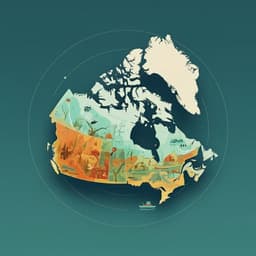
Environmental Studies and Forestry
Climate change reshuffles northern species within their niches
L. H. Antão, B. Weigel, et al.
Climate change is causing significant shifts in species' positions within their climatic niches, particularly at higher latitudes. This research, conducted by a team from the University of Helsinki and other institutions, reveals how biodiversity responses are complicating ecosystem integrity over four decades in Finland.
~3 min • Beginner • English
Introduction
The study addresses how climate change reshapes biodiversity beyond simple range shifts by examining whether and how species shift their positions within multidimensional climatic niche space over time. Prior work has established that species tend to occupy restricted environmental conditions (the niche concept), and that climate warming alters species abundances and distributions, potentially homogenizing communities. However, the relative importance of different climatic dimensions (temperature, precipitation, snow cover, large-scale indices like NAO) may vary across taxa, space, and time, leading to heterogeneous community responses. Long-term, spatially resolved, multi-taxon data are scarce, especially in rapidly warming northern regions. Leveraging a unique four-decade dataset from Finland across a ~1,200 km latitudinal gradient, the authors quantify shifts in species’ relative niche positions across annual mean temperature, total precipitation, snow cover duration, and the NAO index. They hypothesize stronger and more frequent climate-driven responses at higher latitudes, and, given many species’ broader ranges extending south of Finland, expect more species to occupy the lower or optimum parts of their niche space in the north as climate warms.
Literature Review
The paper builds on foundational niche theory and extensive literature documenting climate-driven changes in species distributions, phenology, and community composition. Prior studies show terrestrial and marine species shifting ranges and tracking climate at different paces, sometimes leading to homogenization. Thermal tolerance and ectotherm vulnerabilities suggest latitude-dependent impacts; high-latitude ecosystems are projected as change hotspots. Evidence indicates that multiple climatic dimensions can shape species’ realized niches and that taxon-, region-, and time-specific responses complicate generalizations. Snow cover, despite its importance in high-latitude systems, is often neglected in modeling. The study situates itself among calls for multi-variable, cross-taxon, spatio-temporal analyses to improve projections of biodiversity change under climate warming.
Methodology
Study system and data: The analysis spans Finland (~1,200 km latitudinal gradient) over 1978–2017, covering 1,478 species from birds, mammals, small rodents, butterflies, moths, forest understory vascular plants, and freshwater phytoplankton, sampled at 6,504 sites. Occurrence (presence) data were derived from high-quality monitoring programs; abundance records were converted to occurrences. Spatial units were assigned to bioclimatic zones (hemiboreal pooled with southern boreal → three zones used: south boreal, middle boreal, north boreal). Years were grouped into decades: 1 (1978–1987), 2 (1988–1997), 3 (1998–2007), 4 (2008–2017). Species inclusion required ≥10 occurrences per zone×decade, and subsets needed ≥20 samples and ≥6 species.
Climatic variables: From FMI ClimGrid (10×10 km daily grids), annual mean temperature, annual precipitation sum, and annual snow cover days were derived; annual NAO values were obtained from NCAR. Additional climate metrics were assessed for correlation but excluded due to high collinearity with annual values. Climatic change was quantified via linear models (decade×zone interactions) and k-means clustering (k=4) to characterize spatio-temporal regimes.
Modeling framework: For each taxon×zone×decade, spatially explicit joint species distribution models (JSDMs) were fitted using HMSC (Bayesian GLMM with probit link), totaling 63 models. Fixed effects included quadratic terms for temperature, precipitation, and snow cover, and a linear term for NAO. Random effects included site and year (plants lacked NAO and year due to sampling in only three years). Spatially structured latent variables accounted for residual spatial autocorrelation. Posterior sampling used 4 MCMC chains (burn-in 12,500, thinning 100, 250 samples per chain; total 1,000 posterior samples; with adjustments in one large phytoplankton subset). Convergence was assessed via potential scale reduction factors; model performance via AUC and Tjur’s R².
Niche position classification: For each species and covariate, responses with ≥90% posterior support (non-zero) were classified based on the derivative over the observed environmental gradient: increasing (lower end of niche), bell-shaped (optimum), decreasing (upper end). Threshold rules handled mixed-derivative cases; robustness to thresholds was checked.
Relative importance of covariates: Species-level variance components attributed to each covariate were computed and weighted by model discriminatory power (Tjur’s R²). Linear regressions of variance components against decade estimated temporal trends, compared across zones and taxa.
Community composition: Multiple-site dissimilarity (Sørensen; with turnover and nestedness components) was estimated using betapart, with repeated subsampling to standardize site numbers across zone×decade combinations.
Key Findings
- Climate trends: Warming and increased precipitation were strongest in the northernmost zone; snow cover duration declined markedly in both the northernmost and southernmost zones. Later decades in northern areas resembled earlier-decade climates of more southern zones, especially for temperature and snow cover.
- Niche position shifts: Despite limited species turnover between decades within zones, a large proportion of species shifted their relative positions within climatic niche space (between lower end, optimum, and upper end) across decades. This indicates species moving to new domains within their environmental niches rather than wholesale species pool replacement.
- Latitude dependence: The proportion of species responding to climatic variables increased toward the north, consistent with stronger climatic changes at higher latitudes.
- Temperature dominance: Temperature was the strongest predictor of species occurrence across regions, decades, and taxa. In the north, over time, growing proportions of birds, mammals, and phytoplankton showed positive responses to temperature (indicating thermal release), whereas butterflies in the south showed more optimum or upper-end responses in later decades, suggesting warming may be approaching or exceeding their preferred conditions.
- Other covariates: The proportion of species responding to precipitation declined over time, mainly due to fewer bell-shaped (optimum) responses. Responses to NAO increased over time, predominantly negative (notably for birds and moths), albeit NAO had lower explanatory power than local variables. Snow cover duration was the main predictor in about one-third of models and was especially important for plants, with complex temporal and taxon-specific response patterns.
- Changing explanatory power: The relative importance (variance explained) of climatic variables shifted over time and varied by zone and taxon. For plants and mammals, explanatory power of all variables tended to increase over time (and poleward for plants). For birds, temperature (and precipitation) explanatory power increased through time and with latitude. In contrast, phytoplankton and moths showed decreasing explanatory power of climatic variables over time.
- Community dissimilarity: Spatial homogenization was not strongly directional. Within zones, some taxa became slightly more homogeneous (plants), less homogeneous (birds, butterflies, moths), or showed complex patterns (small rodents). Turnover magnitude and direction differed by zone and taxon, with stronger poleward turnover for birds, butterflies, and moths, and the opposite for phytoplankton. Overall, niche shifts, rather than high species replacement, drove community change.
Discussion
The findings demonstrate that accelerating climate change reshuffles species within their climatic niches across a full high-latitude biome, with strongest imprints toward the pole. By quantifying relative niche positions and tracking their shifts, the study shows that many species are moving toward more favorable thermal conditions (thermal release) in northern zones, while others (e.g., some butterflies in the south) approach or exceed upper thermal limits, yielding winners and losers within co-occurring assemblages. The relative importance of climatic dimensions is spatio-temporally dynamic: temperature’s imprint generally strengthens over time across taxa with diverse dispersal abilities, but precipitation and snow cover effects vary by taxon and zone, and large-scale climatic modes (NAO) increasingly exert negative influences for some groups.
These heterogeneous, context-dependent responses indicate that extrapolations of climate impacts across taxa, regions, or even consecutive decades are prone to error if they neglect shifting exposure and variable importance. While turnover contributes to community change, limited decade-unique species imply that climate-driven restructuring chiefly reflects movement within niche space rather than wholesale species pool replacement. Such asymmetric responses may disrupt species interactions and trophic links, threatening ecosystem integrity, particularly in high-latitude systems undergoing rapid climatic change. The results reinforce temperature’s central role in biodiversity change while emphasizing the necessity to incorporate additional variables like snow cover—especially critical for plants—and to consider regional climate indices.
Conclusion
This cross-taxon, biome-wide analysis provides a framework to quantify how species’ positions within climatic niches shift over decades and how the relative importance of multiple climatic drivers changes across space and time. Key contributions include demonstrating temperature’s dominant and increasing role, revealing broader high-latitude sensitivity with more species responding in the north, highlighting the growing significance of snow cover for plants, and identifying rising negative associations with NAO for some taxa. The work cautions against simple generalizations of biodiversity responses and underscores risks to ecosystem integrity from asynchronous niche shifts among co-occurring species.
Future research should: (1) disentangle whether species’ niches expand, contract, or shift; (2) integrate land-use changes and their interactions with climate; (3) evaluate consequences for species interactions, abundances, and ecosystem functioning; (4) incorporate climate variability and extremes; and (5) improve predictive models that capture spatio-temporal changes in both exposure and the relative importance of multiple climatic drivers.
Limitations
- Geographic scope: Analyses are restricted to Finland; many species have broader ranges, so inferred niche positions reflect conditions within this region.
- Data harmonization: Abundance converted to presence; differences in sampling designs and coverage across taxa and decades may affect detectability and uncertainty, though models include random effects for site/year and spatial latent variables.
- Model scope: Plants lacked NAO and year random effects due to sampling design; some sparse subsets were excluded; computational constraints required subsampling in certain large subsets.
- Covariate set: Focused on annual aggregates of key climate variables; additional seasonal/variability metrics were excluded due to collinearity, potentially omitting nuances relevant to some taxa.
- Causality and confounding: Land-use change and other unmeasured environmental factors may contribute to observed patterns despite accounting for spatial autocorrelation; explicit climate–land-use interaction analyses were beyond scope.
- Outcome measures: The study quantifies occurrence-based niche position shifts rather than changes in abundance, fitness, or demographic rates; it does not directly test niche expansion/contraction versus translation.
Related Publications
Explore these studies to deepen your understanding of the subject.







